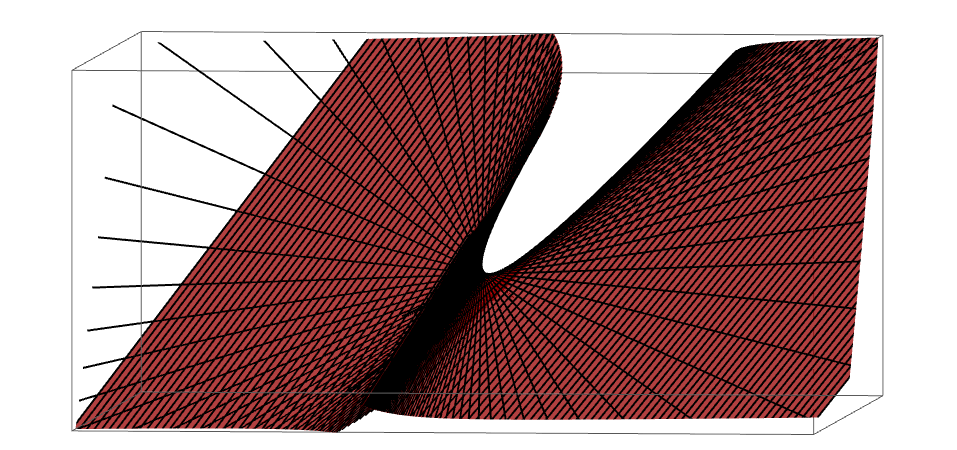


Then, mark the checkboxes below: "Show Points and Vectors", "Show Plane(s)" and "Show Normal Vector of Plane" to compare the points and vectors that make up these lines, the planes they line on, and the normal vectors of the planes, respectively. Use the sliders below to define Line 1 and Line 2 by providing a point and direction vector from which they can be drawn. Because they lie on parallel planes, which share the same normal vector, the distance between the skew lines at their closest point can be calculated as the scalar projection of a vector pointing from one line to another onto the common normal vector. (astronomy of multiple planets or other orbiting bodies) Orbiting a central celestial object within the same orbital plane. Four or more points which do not lie in the. This means they will never cross and do not have similar direction vectors. (geometry of at least two things, usually lines) Within the same plane. A set of points, lines, line segments, rays or any other geometrical shapes that lie on the same plane are said to be Coplanar. Definition 2 The points of a set are said to be coplanar if and only if there is a plane that contains them all. Skew: The two lines are not coplanar but instead lie on parallel planes. Parallel: The two lines are coplanar but never intersect because they travel through different points, while their direction vectors are scalar multiples of one another. Intersecting: The two lines are coplanar (meaning that they lie on the same plane) and intersect at a single point. Ī pair of lines can fall into one of three categories when discussing three-dimensional space: Three vectors coplanarity is a condition in which. Points that lie on the same plane are coplanar points whereas. In three-dimensional space, a plane is a two-dimensional figure that extends to infinity. In geometry, coplanar means lying on the same plane. Three vectors are said to be coplanar if their scalar product is zero. However, this fact does not hold true in three-dimensional space and so we need a way to describe these non-parallel, non-intersecting lines, known as skew lines. Coplanar vectors can be defined as the type of vectors that lie on the same plane and these are also parallel to the same surface. We want to show that if two lines are parallel the two lines are also coplanar. Let A be a set.In 2-dimensional Euclidean space, if two lines are not parallel, they must intersect at some point. By definition, two lines are coplanar iff they lie on the same plane. The discussion so far suggests the following simpler, more intuitive, formulation of incidence geometry: This says that every singleton subset of I 0 ( S ) is of the form I 0 ( p ) for some p. We also have for any flat a, I 0 ( a ) ⊆ I 0 ( S ). From the last remark above, I ( S ) = P, and in particular P k = I k ( S ) ⊂ I ( S ). (astronomy, of multiple planets or other orbiting bodies) Orbiting a central celestial object within the same orbital plane. In particular, a = b if and only if I 0 ( a ) = I 0 ( b ). (geometry, of at least two things, usually lines) Within the same plane. Furthermore, if I 0 ( a ) ⊆ I 0 ( b ), then t ( a ) ≤ t ( b ). It is possible to show that ( a, b ) ∈ I if and only if I 0 ( a ) ⊆ I 0 ( b ) or I 0 ( b ) ⊆ I 0 ( a ). Abstract: The joint invariants of a pair of. In this entry, we will define incidence geometry using abstract notions of sets, functions, and relations (specifically, an incidence relation) and then briefly discuss how this definition is related to the axioms of incidence that we know from high school and college.ĭefinition. Invariant of a pair of non-coplanar conics in space: definition, geometric interpretation and computation. (astronomy, of multiple planets or other orbiting bodies) Orbiting a. Since Hilbert’s publication, his axioms of incidence have been characterized by alternative but equivalent ( ) versions, as well as generalized as to include areas of interests from other branches of mathematics, especially, in combinatorics. (geometry, of at least two things, usually lines or plane figures) Within the same plane. At the end of the 19th century, David Hilbert extended and axiomatized this postulate by adding several companion “ incidence axioms” in his famous “Grundlagen der Geometrie” (). Basically, the first postulate states that we can draw a straight line from one point to another point. However, a set of four or more distinct points will, in general, not lie in a single plane. For example, three points are always coplanar, and if the points are distinct and non-collinear, the plane they determine is unique. Incidence geometry is essentially geometry based on the first postulate in Euclid’s The Elements. In geometry, a set of points in space are coplanar if there exists a geometric plane that contains them all.


 0 kommentar(er)
0 kommentar(er)
